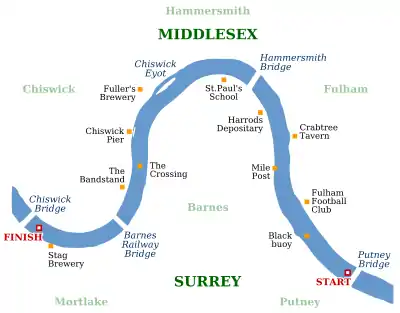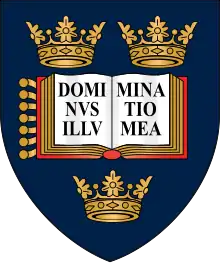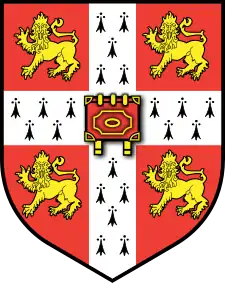The Boat Race 1974
The 120th Boat Race took place on 6 April 1974. Held annually, the Boat Race is a side-by-side rowing race between crews from the Universities of Oxford and Cambridge along the River Thames. It was won by Oxford who passed the finishing post 5 1⁄2 lengths ahead of Cambridge, in a winning time of 17 minutes 35 seconds, the fastest in the history of the race, beating the existing record set in the 1948 race. It was umpired by Ran Laurie.
| 120th Boat Race | |||
|---|---|---|---|
| Date | 6 April 1974 | ||
| Winner | Oxford | ||
| Margin of victory | 5 1⁄2 lengths | ||
| Winning time | 17 minutes 35 seconds | ||
| Overall record (Cambridge–Oxford) | 67–52 | ||
| Umpire | W. G. R. M. Laurie (Cambridge) | ||
| Other races | |||
| Reserve winner | Goldie | ||
| Women's winner | Cambridge | ||
| |||
In the reserve race, Goldie beat Isis, and in the Women's Boat Race, Cambridge were victorious.
Background
The Boat Race is a side-by-side rowing competition between the University of Oxford (sometimes referred to as the "Dark Blues")[1] and the University of Cambridge (sometimes referred to as the "Light Blues").[1] First held in 1829, the race takes place on the 4.2-mile (6.8 km) Championship Course on the River Thames in southwest London.[2] The rivalry is a major point of honour between the two universities and followed throughout the United Kingdom and broadcast worldwide.[3][4] Cambridge went into the race as reigning champions, having beaten Oxford by a thirteen lengths in the previous year's race. Cambridge held the overall lead, with 67 victories to Oxford's 51 (excluding the "dead heat" of 1877).[5][6]
The first Women's Boat Race took place in 1927, but did not become an annual fixture until the 1960s. Up until 2014, the contest was conducted as part of the Henley Boat Races, but as of the 2015 race, it is held on the River Thames, on the same day as the men's main and reserve races.[7] The reserve race, contested between Oxford's Isis boat and Cambridge's Goldie boat has been held since 1965. It usually takes place on the Tideway, prior to the main Boat Race.[6]
During preparation for the race, both crews were defeated on the Thames by the Lubrication Laboratory boat from Imperial College London.[8] Jim Railton, writing in The Times was not impressed: "It has already been well established that there are no top class crews in this ... Boat Race. Each day on the Tideway in the final days of training have simply produced more negatives".[8] Cambridge also lost twice in short races against their reserve crew Goldie, whom Oxford had defeated at the Reading University Head of the River Race by eight seconds.[9] In appalling conditions, Cambridge won an interrupted race against a Barclays Bank crew.[10] Meanwhile, Oxford defeated a "motley eight" from Tideway Scullers School by four lengths along the full course.[9] Oxford's finishing coach was Daniel Topolski (who had rowed for the Dark Blues in the 1967 and 1968 races) while Cambridge were guided by British Olympic rower David Jennens (who had rowed for the Light Blues in the 1949, 1950 and 1951 races),[11] and the race was umpired by Ran Laurie, who had rowed for Cambridge in the 1934, 1935 and 1936 races.[12][13]
Crews
The Cambridge crew was marginally heavier than their opponents, weighing an average of 13 st 5.25 lb (84.7 kg), 0.25 pounds (0.1 kg) per rower more than Oxford.[11] Oxford saw four Blues return to their crew, Nick Tee, Sam Nevin, Dennis Payne and American Olympian David Sawyier, while Cambridge welcomed back two – Ben Duncan and Howard Jacobs.[9]

| Seat | Oxford |
Cambridge | ||||
|---|---|---|---|---|---|---|
| Name | College | Weight | Name | College | Weight | |
| Bow | N. D. C. Tee | Balliol | 12 st 1 lb | R. P. B. Duncan (P) | St Catharine's | 13 st 8 lb |
| 2 | G. S. Innes | Oriel | 13 st 2 lb | H. R. Jacobs | Pembroke | 13 st 6 lb |
| 3 | D. Rendel | St Cross | 13 st 10 lb | D. J. Walker | Clare | 13 st 9 lb |
| 4 | S. D. Nevin | Christ Church | 13 st 13 lb | D. B. Sprague | Emmanuel | 13 st 2 lb |
| 5 | P. G. P. Stoddart | University | 13 st 6 lb | J. H. Smith | Gonville & Caius | 14 st 12 lb |
| 6 | P. J. Marsden | Lincoln | 13 st 6 lb | J. H. Clay | Pembroke | 13 st 4 lb |
| 7 | D. R. Payne | Balliol | 13 st 5 lb | T. F. Yuncken | Pembroke | 12 st 12 lb |
| Stroke | D. R. Sawyier (P) | Christ Church | 14 st 2 lb | N. C. A. Bradley | Pembroke | 12 st 3 lb |
| Cox | G. E. Morris | Oriel | 8 st 12 lb | H. J. H. Wheare | Jesus | 8 st 11 lb |
| Sources:[11][14] (P) – Boat club president[15] | ||||||
Race

Cambridge won the toss and elected to start from the Middlesex station.[16] Oxford took an early lead with their stroke Sawyier making a good start. Despite this, by the Mile Post, Oxford were just one-third of a length clear, and while Cambridge's stroke rate was lower than their Dark Blue opposition, they remained in contention. By Hammersmith Bridge, Oxford held a two-length lead, and despite favourable wind and ride, Cambridge failed to respond. At Chiswick Steps, the lead had extended to four lengths and by Barnes Bridge it was five. Oxford passed the finishing post in a record-breaking time of 17 minutes 35 seconds, breaking the existing record from the 1948 race, 5 1⁄2 lengths clear of the Light Blues.[16] Railton commented: "Tideway records reflect conditions more than comparisons with previous Boat Race crews" but noted "considering the slow conditions ... Oxford's performance must have been particularly inspired."[16] The winning time was two seconds faster than the best time over the course, set by Oxford in practice in 1965, and 15 seconds quicker than the race record, set in the 1948 race by Cambridge.[17]
In the reserve race, Cambridge's Goldie beat Oxford's Isis by five lengths, their seventh consecutive victory.[6] In the 28th running of the Women's Boat Race, Cambridge triumphed, their eleventh consecutive victory.[6]
References
Bibliography
- Dodd, Christopher (1983). The Oxford & Cambridge Boat Race. Stanley Paul. ISBN 0-09-151340-5.
- Burnell, Richard (1979). One Hundred and Fifty Years of the Oxford and Cambridge Boat Race. Precision Press. ISBN 0-9500638-7-8.
Notes
- "Dark Blues aim to punch above their weight". The Observer. 6 April 2003. Retrieved 8 April 2014.
- Smith, Oliver (25 March 2014). "University Boat Race 2014: spectators' guide". The Daily Telegraph. Retrieved 3 June 2014.
- "Former Winnipegger in winning Oxford–Cambridge Boat Race crew". CBC News. 6 April 2014. Retrieved 7 April 2014.
- "TV and radio". The Boat Race Company Limited. Retrieved 5 July 2014.
- "Classic moments – the 1877 dead heat". The Boat Race Company Limited. Archived from the original on 28 October 2014. Retrieved 12 October 2014.
- "Men – Results". The Boat Race Company Limited. Retrieved 19 July 2014.
- "A brief history of the Women's Boat Race". The Boat Race Company Limited. Archived from the original on 6 October 2014. Retrieved 5 July 2014.
- Railton, Jim (3 April 1974). "Two indifferent crews could liven up Boat race series". The Times (59055). p. 7.
- Railton, Jim (4 April 1974). "Oxford tails high as Cambridge lose twice to reserve crew". The Times (59056). p. 19.
- Railton, Jim (5 April 1974). "Conditions present crews with problems". The Times (59057). p. 13.
- Railton, Jim (6 April 1974). "Battle of strokes is key to Boat Race outcome". The Times (59058). p. 17.
- Rodda, John (6 April 1974). "Equality of crews to restore excitement". The Observer. p. 17.
- Dodd pp. 328–29
- Burnell, pp. 51–52
- Railton, Jim (2 April 1974). "Monday blues on the Tideway". The Times (59054). p. 9.
- Railton, Jim (8 April 1974). "Aggression of Sawyier lifts Oxford from gloom". The Times (59059). p. 8.
- Donne, Michael (8 April 1974). "Oxford had it sewn up at Hammersmith". Financial Times (26333). p. 3.

